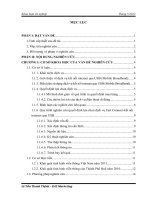Yếu tố ảnh hưởng đến việc không thống nhất dùng bao cao su ở những người có quan hệ tình dục đồng giới nam_Factors associated with inconsistent condom use among men who have sex with men in cambodia
Bạn đang xem bản rút gọn của tài liệu. Xem và tải ngay bản đầy đủ của tài liệu tại đây (349.94 KB, 20 trang )
Factors Associated with Inconsistent Condom
Use among Men Who Have Sex with Men in
Cambodia
Presented by: Pheak
Chhoun, MPH
Research Fellow, Center for Population Health Research
Investigators:
KHANA (Cambodia): Siyan Yi, Sovannary Tuot, Pheak Chhoun, Khuondyla Pal, Khimuy Tith
Touro University California (USA): Siyan Yi, Carinne Brody
th
7 ICPH, Hue City, Vietnam | 26-27 September 2015
1
MSM and HIV
•
Less progress in reducing HIV prevalence and incidence among men who have sex with men (MSM)
(Beyrer et al 2012 & CDC 2012)
•
MSM are at greater risk for HIV acquisition and transmission due to their more hidden and stigmatized
nature, compounded by limited access to basic prevention materials such as condoms and lubricant
(Altman et al 2012 & Trapence et al 2012)
•
HIV prevalence in MSM ranged from 3.0% in the Middle East and north Africa region to 25.4% in the
Caribbean
(Beyrer et al 2012)
2
MSM and HIV in Cambodia
•
HIV prevalence and sexual behaviours among MSM remain of great concerns despite encouraging declines
in new HIV infections in the general population
(Vun et al 2014 & Liu 2010)
•
•
Prevalence of HIV among MSM: 2.2%
Prevalence of sexually transmitted infections (STIs) among MSM: 51.5%
(Liu 2010)
•
•
MSM had sold sex to men in the past 12 months: 26.9%
Rates of consistent condom and lubricant use with male clients in the past months: 35.7% and 49.5%
(NCHADS 2013)
3
Rationales and Objectives
•
Rationales
– Greater risk for HIV
– Less understood due to their hidden and stigmatized nature
– Discrepancy in findings in the literature
•
Objectives: to explore factors associated with inconsistent condom use among high-risk
MSM in Cambodia
4
Study design
•
•
Cross-sectional study
Two-stage cluster sampling method:
– Communes (third-level administrative divisions) in each province used as the smallest
unit for the sampling process
– Probability proportional-to-size sampling method was used to select the required
number of MSM from each commune
5
Study population and Sample size
•
•
•
Sample size: 367 MSM
Study period: April and May 2014
Inclusion Criteria:
– 18 years or older
– self-reported as an MSM
– sexually active in the past three months
– able to provide consent to participate in the study
– available for a face-to-face interview on the day of the data collection
6
Map of the Study Sites
7
Measurements
•
•
•
•
•
•
•
Sociodemographic characteristics
HIV testing history
Self-perception of HIV risk
Substance use
Sexual behaviors
Mental disorders
HIV knowledge
8
Data Analyses
•
•
Double data entry: EpiData
Bivariate analyses:
– Chi-square or Fisher’s Exact test for categorical variables
– Student’s t-test for continuous variables
•
Multivariable logistic regression model
– Controlling potential confounders
– Including all variables associated with condom use in bivariate analyses at the level of p< 0.05
– Soft wares: SPSS version 22
9
Ethical Considerations
•
Ethical approval:
–
•
•
National Ethics Committee for Health Research (NECHR)
Written informed consent: All participants
Confidentiality & privacy protection:
–
–
No personal identifier collected
Interviews at private places
10
Comparisons of characteristics of MSM who reported always using condoms and MSM who reported not always using condoms
Socio-demographic characteristics
Mean age (in year)
Condom use in the past 3 months
Total
Always
Not always
(n = 367)
(n = 230)
(n = 137)
23.9 ± 5.2
23.2 ± 4.5
25.1 ± 6.1
Gender identity
Men
0.001
0.45
207 (56.4)
124 (54.0)
83 (60.6)
Women
79 (21.5)
53 (23.0)
26 (19.0)
Other (including ‘both’)
81 (22.1)
53 (23.0)
28 (20.4)
Self-rated overall health status
0.004
Good/very good
135 (36.8)
70 (30.4)
65 (47.4)
Neither good nor poor
210 (57.2)
146 (63.5)
64 (46.7)
22 (6.0)
14 (6.1)
8 (5.8)
Poor/very poor
p-value*
11
Comparisons of characteristics of MSM who reported always using condoms and MSM who reported not always using condoms (Con.)
Condom use in the past 3 months
Total
Always
Not always
(n = 367)
(n = 230)
(n = 137)
Self-rated overall quality of life
<0.001
Good/very good
106 (28.9)
45 (19.6)
61 (44.5)
Neither good nor poor
243 (66.2)
173 (75.2)
70 (51.1)
18 (4.9)
12 (5.2)
6 (4.4)
Poor/very poor
p-value*
Self-perception of HIV risk compared to the general population
0.006
Higher
132 (36.0)
70 (30.4)
62 (45.3)
Same
64 (17.4)
39 (17.0)
25 (12.8)
Lower
171 (46.6)
121 (52.6)
50 (36.5)
12
Comparisons of substance use of MSM who reported always using condoms and MSM who reported not always using condoms
Condom use in the past 3 months
Drunk at least a full glass of alcohol
Mean number of days getting drunk in past month
Total
Always
Not always
(n = 367)
(n = 230)
(n = 137)
322 (87.7)
186 (80.9)
125 (91.2)
0.04
5.1 ± 6.8
4.4 ± 5.8
6.2 ± 8.0
0.02
Self-perception of level of alcohol drinking
p-value*
0.29
28 (8.7)
19 (9.7)
9 (7.2)
Social drinkers
287 (89.4)
175 (89.3)
112 (89.6)
Heavy drinkers
6 (1.9)
2 (1.0)
4 (3.2)
16 (4.4)
4 (1.7)
12 (8.8)
Non-drinkers
Used some kinds of illicit drugs
13
0.001
Comparisons of sexual behaviours of MSM who reported always using condoms and MSM who reported not always using condoms
Condom use in the past 3 months
Mean number of sex partners
Total
Always
Not always
(n = 367)
(n = 230)
(n = 137)
Comparisons of substance use of MSM who reported always using
4.0 ± 5.5
4.7 ± 6.3
condoms and MSM who reported not always using condoms
Socio-demographic characteristics
Always used lubricant when selling anal sex
41 (64.1)
9 (21.4)
14
p-value*
3.4 ± 3.8
0.03
14 (63.6)
0.001
Factors associated with inconsistent condom use among MSM in multivariable logistic regression model
Variables in the final model*
Inconsistent condom use in the past 3 months
AOR (95% CI)
p-value
Age group
<=24
Reference
>=25
1.77 (1.09–2.86)
0.02
Self-rated overall quality of life
Neither good nor poor
Reference
Poor/very poor
2.33 (0.62–8.72)
0.36
Good/very good
4.37 (1.79–5.67)
0.001
Perception of HIV risks compared to general population
Same
Reference
Lower
0.75 (0.39–1.47)
0.40
Higher
2.37 (1.35–4.17)
0.003
Factors associated with inconsistent condom use among MSM in multivariable logistic regression model
Variables in the final model*
Inconsistent condom use in the past 3 months
AOR (95% CI)
p-value
Illicit drug use in the past 3 months
No
Reference
Yes
5.76 (1.65–10.09)
0.006
Lubricant use when selling anal sex to men in the past 3 months
Not always
Always
Reference
2.85 (1.07–8.12)
16
0.03
Discussion
•
Having multiple commercial and non-commercial partners combined with inconsistent condom use may
result in high risk of HIV and STI acquisition and transmission
•
Condom use rates across all types of relationship remained considerably low
•
Illicit drug users were significantly more likely to report inconsistent condom use compared to non-users
•
MSM in the age group of 25 or older were significantly more likely to report inconsistent condom use
compared to younger MSM in the age group of 24 or younger
17
Limitations of the study
•
•
Limited sample size
•
•
•
Representativeness of the study population
MSM in this study include TG (may have different characteristics and sexual
behavior)
Cross-sectional design precludes interpretation of the finding
Self-reported measures: Underreporting and over-reporting
Conclusions
•
•
Risky sexual behaviours was considerably high among MSM, especially those
who used illicit drugs or were older than 25
HIV education and social marketing should be expanded and specifically
designed for MSM to better educate on:
– the increased risk of HIV with unprotected anal sex and illicit drug use as risk factors
– the importance of the use of both condoms and lubricant during anal intercourse
Acknowledgement
•
•
•
•
•
•
NCHADS
PHDs, ODs
USAID
Implementing partners and their staff members
Study participants, local authorities
Research team members









